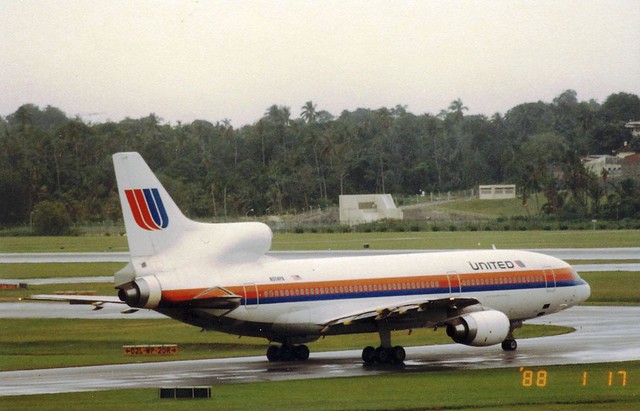
Click the pic to see it over at flickr - or click this link to see it there in its largest size
The time stamp on this pic makes it clear that it isn't a recent pic... and that should be obvious since the major airlines stopped using the Lockheed L-1011 TriStar many years back. But what makes this pic so interesting is that many people don't know that United Airlines operated L-1011's at all.
United had opted for the similarly sized (and also 3 engine) McDonnell Douglas DC-10 over the L-1011 in the early 70's. The two airplanes were very similar, but the TriStar marked Lockheed's first modern attempt at producing an aircraft that would appeal to the airlines, and a variety of factors made their road to success difficult to navigate. Two of the largest hurdles were the delays in getting the Rolls Royce RB211 engines on time, and the fact that the L-1011 was more complex (more advanced?) and thus more difficult and expensive to buy and maintain. Had the L-1011 entered service before the DC-10, and had McDonnell Douglas not lowered the price of the DC-10 to make it cheaper to acquire, things might have ended up very different. In the end, 250 L-1011's were built compared to 386 DC-10's (436 total if you count the KC-10 tanker variants) - and that just wasn't enough TriStar's to ultimately make the program a success. The Tri-Star's are a much-loved aircraft tho and Lockheed did a great job in bringing the airplane to the market.
 United operated a large fleet of DC-10's, and I rode many of them as a kid! (photo: wiki)
United operated a large fleet of DC-10's, and I rode many of them as a kid! (photo: wiki)
But what's the deal with United actually having the L-1011? Well, they were really Pan Am TriStars that were purchased by United when they bought the Pacific Division from Pan Am around 1986. These routes comprised about 25% of Pan Am's entire route structure, but were sold off in a desperate effort to try to keep Pan Am from bleeding to death as an airline. As you probably already know, it didn't really help... Pan Am went under in 1991.
When United bought those routes, and the airplanes that flew them, it was really the routes that they wanted. The six L-1011's were just part of the package, and since maintaining such a small fleet of totally different aircraft was not cost effective, United sold them off in just a few short years. But it makes an interesting footnote in the history of both United and the L-1011 that a handful of airplanes like the one above were painted in the Saul-Bass-designed livery and operated by United.
(QuickPic image from flickr.com/photos/22331715@N06/ - more great pix over there!)
 Sunday, October 16, 2011 at 10:09PM
Sunday, October 16, 2011 at 10:09PM  Alaska,
Alaska,  Cub,
Cub,  aerodynamics,
aerodynamics,  homebuilt,
homebuilt,  video
video  Email Article
Email Article 






















































































